Planning to spend 2 days in Granada, and looking to see as much as possible? There are so many things to see in Granada including the famous Alhambra. This 2-day itinerary will help you make the most out of your stay in Granada.
Granada, Spain, an Andalusian city famed for its Alhambra Moorish palace and gardens, is a beautiful and historic city that draws in travelers from all over. Its most famous features are the Albaicin, Alhambra, and Generalife.
While the region has been settled since the 5500s BCE, the city itself was founded in or around the 8th century AD by Arabs. It remained under Arab control from centuries, until the Reconquista of the late 15th century, when Ferdinand II of Aragon and Isabella I of Castile, Catholic monarchs, conquered the city in 1492. Granada was home to Katherine of Aragon before she left for England to marry Arthur, and later Henry VIII.

Most of the city’s famed Spanish-Islamic art and architecture dates from the Moorish era, namely the Alhambra and Generalife, while the city center itself is predominantly 17th-19th century. Two days in Granada is plenty to experience this lush city at the foothills of the Sierra Nevada mountains. Here are my recommendations for two days in Granada, Spain.

Disclaimer: This post contains affiliate links. This means that should you click on certain links, and then subsequently purchase a product, I will receive a small commission.
Table of Contents
A Comprehensive 2 Day Granada Itinerary

Map of Granada in 2 Days

2 days in Granada: Day One
Catedral de Granada

The Cathedral of Granada is located in the center of the city on the ruins of the Nasrid Empire Great Mosque of Granada. It was built in the early 16th century and is modeled after the Cathedral of Toledo, but the architect changed halfway through, so the early Gothic design was remodeled into a Renaissance project, and yet later given a Baroque facade.
Royal Chapel of Granada

The Royal Chapel of Granada, located next door to the Cathedral of Granada, is the burial place of Ferdinand II of Aragon and Isabella I of Castile, who died within 15 years of each other in the early 16th century.
Their daughter Joanna of Castile, the Mad Queen, and her husband Philip I of Castile are also buried here. In the crypt is the sarcophagus of Ferdinands and Isabella’s grandson Miguel, son of their daughter Isabella. Like the cathedral, the royal chapel is built on the ruins of the Great Mosque. Because it is still a working chapel, at times it is closed to tourists.
The Alcaiceria

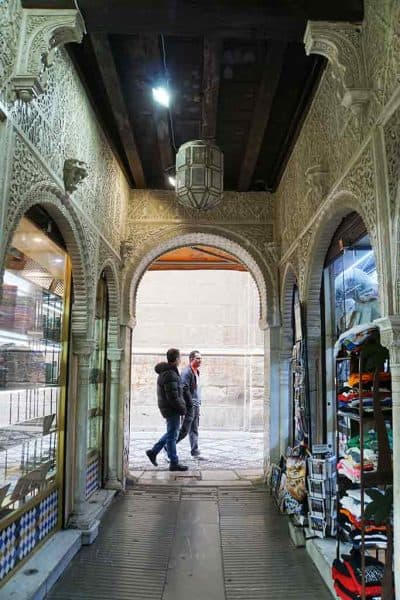
The Alcaiceria is a maze of narrow alleyways with a distinctly Moorish feel. It was formerly the Moorish silk market or the Grand Bazaar, but today has only one remaining street that runs from Calle Reyes Catolicos to the Cathedral.
The original bazaar dated back to the 15th century, but was sadly destroyed by fire in the 18th century and reconstructed into its modern form. They originally sold silks, after Byzantine Emperor Justinian, granted Arabs the exclusive right to manufacture and sell silk, spices, and other luxurious goods.
Carrera del Darro

The Carrera del Darro is the name given to the entire left bank of the river Darro, which runs through Granada. The cobblestoned street runs along the river, between the Alhambra forest and the hills of the Almanzora, and is one of the most picturesque spots in the city.


You will see the last remaining arched stone bridges crossing the river along this street. Carrera del Darro dates back to the 17th century and has some of the city’s oldest houses (including some early Arab houses) and interesting architecture.
El Bañuelo

El Bañuelo, or Bano del Nogal, are remarkably well preserved 11th-century Muslim baths, located underneath a private home in the Carrera del Darro. It is said that they were saved from destruction by the Catholic monarchs because the home was built on top of them as the Reconquista began. It was previously part of a mosque and would have been a regular meeting place for local men and women (at different times). Brides also visited the bath prior to their wedding.

Tourists can buy the Monumentos Andalusíes ticket on the Alhambra webpage, which will allow you to visit the Bañuelo, the Dar al-Horra Palace (in the Albaicin), the Horno de Oro House, and the Corral del Carbón. This joint ticket costs only 5 euros, but entry to these monuments is free on Sundays.
Horno de Oro

Horno de Oro is one of the best-preserved examples of a Morisco (Catholic Moorish) house in Granada. It is laid out like a traditional Arab house, with an enclosed courtyard offering privacy and protection from the street, and rooms overlooking this courtyard.
Mirador de San Nicolás
The Mirador de San Nicolás is possibly the most famous – and most picturesque – viewpoint in Granada. Located in the Albaicin, it allows breathtaking views of the Alhambra, Generalife Gardens, Sierra Nevada mountains, and the sunset. The little plaza is surrounded by tapas bars, cafes, houses, and the Church of San Nicolas.
Albaicin District

The Albaicin, or Albayzin, is a Moorish neighborhood across the river from the Alhambra. Much of the neighborhood offers beautiful views across the Darro valley to the Alhambra. It is one of the oldest neighborhoods in the city, dating back to the Nasrid Kingdom, the last Moorish Muslim period before the Reconquista.

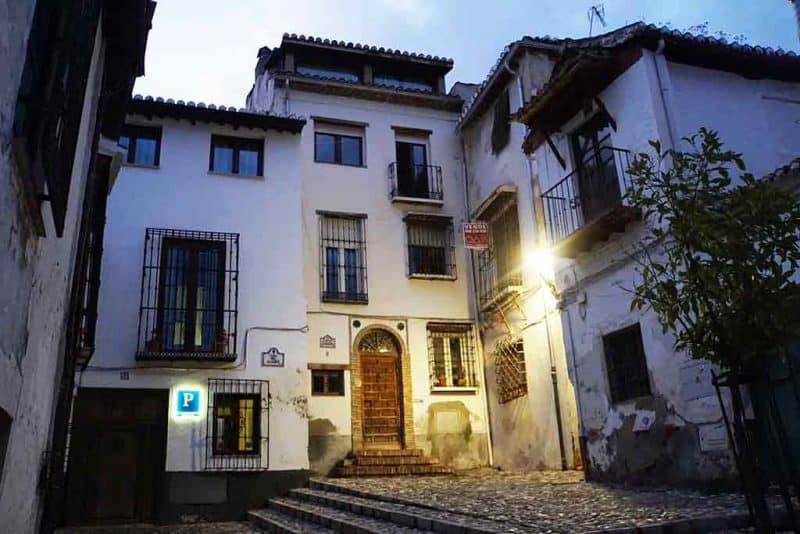

Some of the most important buildings in the Albaicin include the Dar al-Horra Palace, the 15th-century residence of the last Nasrid queen, and the Banuelos. Because of the Albaicin’s history and early development, the entire neighborhood retains the narrow winding streets that run from the top of the hill at the Church of San Nicolas down to the river.
Watch a Flamenco Show
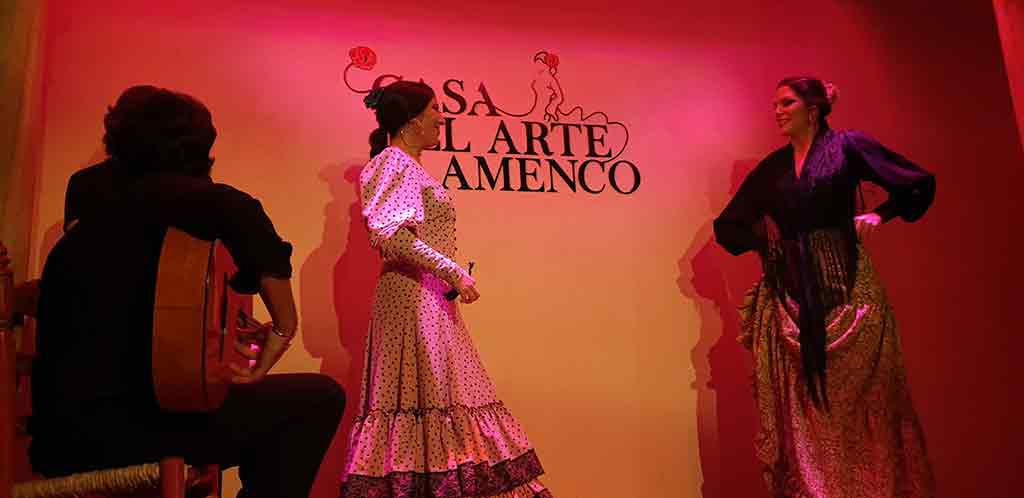
Flamenco is the famous dance of southern Spain, characterized by its flamboyant and passionate singers, dancers, and guitar players. Presumed to have been invented by gypsies and immigrants to Spain during the 15th and 16th centuries, flamenco likely arose through a cultural fusion of Roma gypsies, Arabic moors, and others. Flamenco is a must-do while in Andalusia. There are many places to go, but it is important to find an authentic flamenco show, like the one we attended.

2 Days in Granada: Day Two
Alhambra
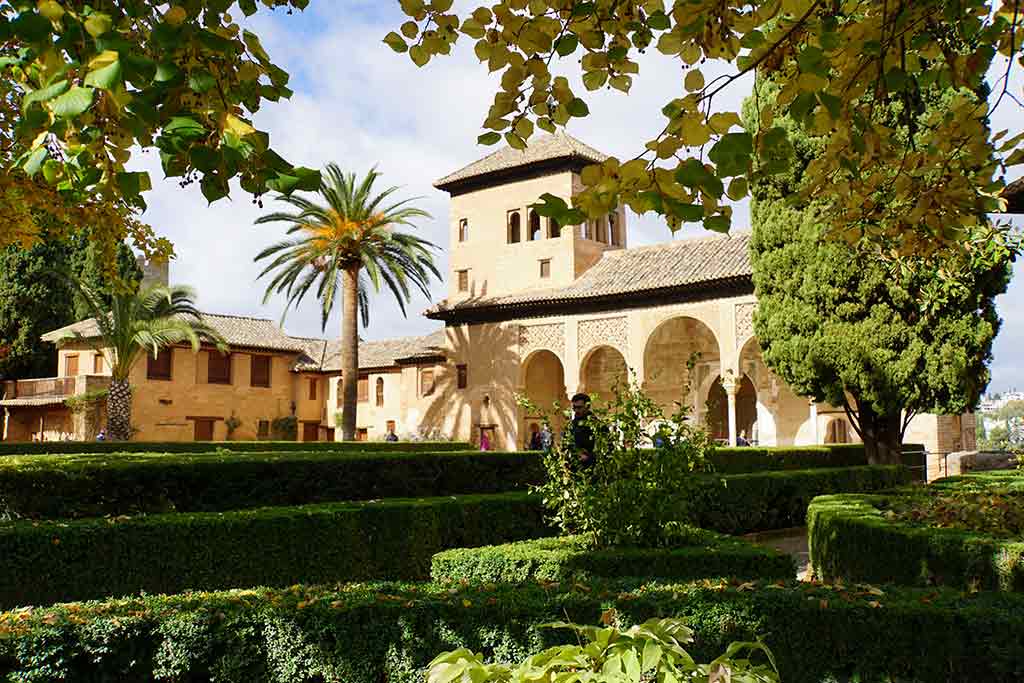
The Alhambra is the most famous building in Granada. Built by Muslims in the 9th century, conquered by Ferdinand and Isabella in the 15th century, partially demolished by Charles V in the 16th century, and abandoned in the 18th century, the Red Castle has certainly been through a lot.

The palace complex sits atop a strategic hill overlooking the Darro River and the city of Granada, with the Albaicin and Sacromonte on opposite hills. The Alcazaba, or military fortress, already existed in this place by the time the Muslims came, and it was here that they stayed until the Nasrid king Mohammed I established royal residence at the Alhambra.



His successors Mohammed II and III (late 13th century) began reconstruction on the Alcazaba as well as the initial construction of the palaces, public baths, warehouses, and more. However, it is Mohammed III’s successors who built what we know and see today as some of the most glorious features of the palace: the Court of the Lions, Justice Gate, Comares Room, and Hall of the Boat.

The Court of the Lions may be among the most popular stops in the palace. It is known for its marble fountain where twelve lions jet streams of crystal clear water, its surrounding exemplary Moorish arcade, and beautiful marble floor.
The Nasrid Palaces are the early Alhambra, and it was here that Katherine of Aragon lived as a young girl before going to England. Her sister, Joanna, had a son – Charles – who became Charles V, Holy Roman Emperor. He ordered the demolition of part of the palace to make room for his new palace, the Renaissance Palace of Charles V, which can still be seen today adjacent to the Nasrid palaces.

The Generalife gardens are also adjacent to the Nasrid Palace and are definitely a must-see. They were a respite for the royal family from the needs of the palace, where they could escape into nature – flowing waterfalls and fountains, lush gardens, fragrant trees, and novelties in every corner. There are minimal buildings here, though there are some because this was also a palace. The Generalife gardens are the best example of Arab gardens in Spain.
Tips for Visiting the Alhambra
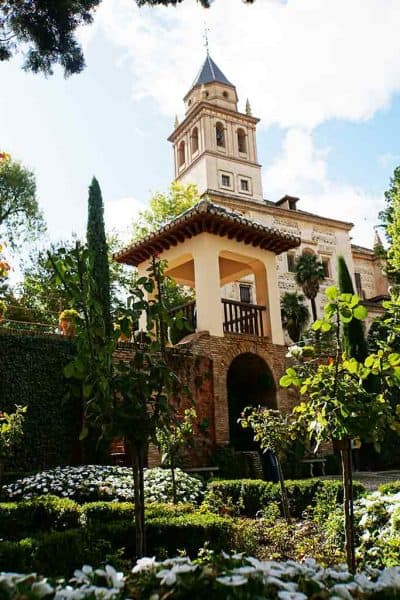

It is very important to book tickets in advance! If you can, book your entry time at least a month out from your intended visit. You must specify a specific time when booking your ticket, so make sure you purchase a ticket for when you know you can get there, otherwise, you won’t be allowed in.
A guided tour is often better at a place like the Alhambra because you have the added benefit of a local guide who can share the history and facts, as well as legends, of the Alhambra and its surroundings. You can choose from a skip the line guided tour to the Alhambra Palace and Generalife Gardens. work with a travel advisor on a custom itinerary and have private guides or book your tickets online and explore on your own. I am a fan of guided tours as you get a lot more from your visit



Plan ahead and be patient. The Alhambra gets more than 6,000 visitors per day during high season, so you can expect long lines and crowds at all the popular spots. It is best to set aside a full day for your trip to the Alhambra.
Cars are not permitted at the Alhambra, so you have two ways to get there. You can walk from the city center – a lovely 30 minute walk up a steep hill under beautiful shady trees – or take a bus or taxi, which can drop you off at the Alhambra ticket office.
Sacromonte neighborhood

The Sacromonte neighborhood, north of the Alhambra and east of the Albaicin, is one of Granada’s most picturesque neighborhoods. However, its history is dark, because this was the area in which the gypsies settled when they were not allowed to live in the city itself. It is a small neighborhood, and very compact, mainly due to the fact that when the Roma settled here, they built their homes into the cliff.
These cave houses are warm in the winter and cool in the summer. Today, Sacromonte has a vibrant main street filled with tapas bars, and it’s here you should go for tapas. The gitanos, or gypsies, are also credited with the true Andalusian form of flamenco, so you’re sure to find a good if touristy, show in this area. There is also a museum that describes the neighborhood, but not the people, and it is a bit of a walk from the main road. Still, it’s worth seeing if you are interested in the history of Sacromonte.
How to Get to Granada

You have a few ways to get to Granada. There is an airport 12km from the city, but there are few flights into Granada. Most often, it is easier to fly to Malaga (90 minutes from Granada) and take a bus or rent a car to drive to Granada.
A car is helpful if you are exploring other parts of Spain by car, but once in the city, you will not need it as the city is very walkable. Parking in Granada is expensive as well.
Many people arrive in Granada by bus from another city in Spain. There is a good bus network from Madrid and Seville, as well as Malaga as noted, and others. You may have to change buses depending on where you are traveling from.

The final way to get to Granada is by train. The AVE (Spain’s high-speed train) now links Granada with Madrid and Seville (as of June 2019). You can also take the regional train from Barcelona or other towns across Spain.
Where to stay in Granada
Gar Anat Hotel Boutique: A small, cozy, and very historical hotel. It gives off a vibe of Granada’s architectural spirit but also has calm, cool, and beautiful rooms with a Granada-styled courtyard for your morning cup of coffee. The hotel is also 5 minutes away from Granada Cathedral.
Click here for more information and to check the latest prices.
Hotel Granada Center: One of the most renowned hotels in Granada, the Hotel Granada Center is only 10 minutes away from the old town and has free Wi-Fi, great rooms, and an a la carte restaurant. You’ll also be 10 minutes from the Granada Cathedral!
Click here for more information and to check the latest prices.
Granada, Spain is a must-visit for its long history through various cultures, its incredible culture of flamenco and tapas, and its many neighborhoods in which to get lost. Go for the UNESCO World Heritage combination of the Alhambra, Albaicin, and Generalife, the vibrant “new” city with its many tapas and wine bars, the fabulous shopping, and the mild, temperate climate. This historic city deep in the Sierra Nevada foothills will astound you.
Traveling further in Spain? Then you might be interested in the following posts:
How to spend 10 days in Spain
One day in Seville
Two days in Seville
Things to do in Cordoba
How to spend one day in Cordoba
A 3 day Madrid itinerary
How to spend 2 days in Madrid
2 days in Barcelona
2 days in Valencia
